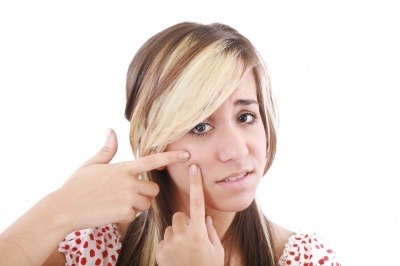
Every teenage nightmare must be to look in the mirror and see superating spots on the face ! Most of us have probably suffered if that isn’t too strong a word with what is a normal and typical skin condition especially in adolescence. It affects both sexes usually during puberty but for some more than others.
The skin is the largest organ in the body and whilst we rely on it for temperature regulation, protection and presenting ourselves to the rest of the world, it is also a strong indicator of health especially where hormonal changes are occurring.
In Western populations, acne, also called acne vulgaris (common acne) is reckoned to affect between 80% and 95% of adolescents, between 40 and 54% of us older than 25 years, and in middle age, about 12% of women and 3% of men (Cordain et al., 2002). Clearly, acne can be with us throughout much of our life. What is interesting is that some tribes have very rare cases of acne like the Inuit, the islanders from Okinawa and Kitavan (Schaeffer et al., 1971).
What is skin and why Is it controlled by sex hormones ?
The skin is composed of many layers. Acne affects the sebaceous glands that lie in the skin’s outer layer (epidermis). These glands produce sebum which is a mixture of wax and various oils that lubricate the outer skin layer and prevents excess water loss from the body. This sebum travels to the skin’s surface via a skin pore.
The production of sebum from the sebaceous glands is under control to some extent by male and female sex hormones. The ‘male hormone’, testosterone stimulates and increases the size and activity of the gland, whereas female hormones such as oestrogens and progesterone perform the opposite. In some cases, female acne is controlled by prescribing contraceptives because of their ability to reduce the size of such glands.
Male and female acne appears to be associated with high levels of testosterone. This hormone triggers large amounts of sebum to be produced which is not normally an issue other than generating very oily skin. Testosterone however also stimulates the cells that line the pores to produce a protein called keratin.
The problem of acne arises when the increase in testosterone levels also raises the pores’ production of keratin which binds to the sebum and blocks the pore. The result is an enlarged, swollen and inflamed pore which is a typical symptom of acne. These swollen blocked pores can also become infected due to bacteria and toxins which are normally present in the pore but cannot escape. This swelling results in the formation of a white headed pimple, a pustule or inflamed lump which can become so severe that the surrounding skin becomes damaged leaving a superating spot, scarring and in the long term, pitted skin.
Increasing evidence is also being pointed at raised levels of insulin whose production is stimulated by high glycaemic loaded diets. There is enough experimental and clinical evidence to show that insulin can increase sex hormone production amongst a host of other hormones which are steroidal based. It is also found to affect enzymes in the steroid hormone production pathway, to promote gonadotrophin releasing hormone secretion (Willis et al., 1996) and production of sex hormone–binding globulin (Plymate et al. 1995; Haffner, 1996; Goodman-Gruen and Barret-Connor, 1997) . Additionally, insulin has been shown to decrease a binding protein for IGF-I, which may facilitate the effect of IGF-I on cell proliferation (Powell et al., 1991)
Other Conditions
Whilst the hormonal changes during puberty are usually associated with adolescent acne, liver damage is also an underlying cause. Whilst it is not the function of this article to review such a condition, it needs to be considered when acne occurs at other times of life. Incidentally, acne is not a couple of spots on the face !

Foods That Influence Sex Hormonal Levels.
Some basic changes to lifestyle are claimed to have an influence on hormonal changes especially during puberty and to possibly reduce the impact of acne. They are:-
- ♦ Coffee and tea to be limited to one cup a day and caffeinated soft drinks to be avoided too
- ♦ Regular meals and each following good nutritional guidelines
- ♦ Regular exercise
- ♦ Low-glycemic meals rather than high-glycemic ones
- ♦ Water – doesn’t matter if its tap or filtered as long as the body is regularly hydrated
- ♦ A reduction in alcohol consumption
The number of well-controlled dietary studies that have examined the effect of diet on acne are rather low in number. One study looked at the effect of daily consumption of various foods including chocolate, milk, or nuts and found no effect on acne (Anderson, 1971). However, this study was questioned because of its small sample size, too rapid follow-up, and general lack of control during the investigation (Margin et al., 2005).
Nutrients for healthy skin
Chocolate incidentally may have an impact on generating acne as the evidence is still being disputed. In 1969, a study was designed to clear up the myth surrounding chocolate where a crossover single-blind study (Fulton et al., 1969), was conducted that found no effect of chocolate on acne when compared with the placebo bar (i.e. no chocolate). However, examination of the ingredients in the placebo bar showed that the fatty acid composition and sugar contents were too similar to that found in the chocolate (Mackie and Mackie, 1974).
- Vitamin A – part of cell formation and regeneration. Skin cells tend to form and grow faster than others so this vitamin is required for healthy skin formation. Vitamin A has a natural immune boosting property for all mucus membrane and body surfaces and has long been linked as one of the top vitamins for skin health. It is found in oily fish, eggs and yoghurt whilst beta carotene the vitamin A precursor is found in orange/yellow fruits and vegetables.
- Vitamin B12 – Recent research suggests adequate intake of this vitamin supports skin health.
- Vitamin C – helps with the production of collagen and elastin two protein component of skin which generates good firm skin tone. This nutrient also has immune enhancing properties and helps with skin healing. Found in citrus fruits, peppers, broccoli, Brussels sprouts, sweet potatoes and kiwi fruit.
- Vitamin E – acne tends to cause scaring and this vitamin is essential for helping with skin recovery and reducing the impact of the condition. It is a potent antioxidant and helps ward off infection and is part of hormone regulation and balance. The vitamin is sourced from nuts, oils, wheatgerm, many different fruits, corn or maize and olive oil.
- Glutamine – this amino acid helps to clear acne by balancing blood sugar levels and stabilising the stress response whilst also having a positive effect on intestinal health. It is found naturally in fish and meat and can also be ingested as a supplement.
- Saw Palmetto – this berry extract is usually consumed as a capsule and helps both sexes maintain and regulate normal testosterone levels.
References
Anderson, P. (1971) Foods as the cause of acne. Am. J. Fam. Pract. 3 pp. 102–3.
Cordain, L., Lindeberg, S., Hurtado, M., Hill, K., Eaton, B., Brand-Miller, B. (2002) Acne vulgaris—a disease of Western civilization. Arch Dermatol. 138 pp. 1584 –9
Fulton, J., Plewig, G., Kligman, A. (1969) Effect of chocolate on acne vulgaris. JAMA 210: pp. 2071– 4
Goodman-Gruen, D., Barret-Connor, E. (1997) Sex hormone-binding globulin and glucose tolerance in postmenopausal women. The Rancho Bernardo study. Diabetes Care 20 pp. 645–9.
Haffner, S. (1996) Sex hormone-binding protein, hyperinsulinemia, insulin resistance and non-insulin-dependent diabetes. Horm. Res. 45: pp. 233–7
Mackie, B., Mackie, L. (1974) Chocolate and acne. Aust. J. Dermatol. 15: pp. 103–9.
Margin, P., Pond, D., Smith, W., Watson, A. (2005) A systematic review of the evidence for ‘myths and misconceptions’ in acne management: diet, face-washing and sunlight. Fam. Pract. 22 pp. 62–70.
Plymate, S., Matej, L., Jones, R., Friedl, K. (1995) Inhibition of sex hormonebinding globulin production in the human hepatoma (HepG2) cell line by insulin and prolactin. J. Clin. Endocrinol. Metab. 67 pp. 460–4
Powell, D., Suwanichkul, A., Cubbage, M., DePaolis, L., Snuggs, M., Lee, P. (1991) Insulin inhibits transcription of the human gene for insulin-like growth factor-binding protein-1. J. Biol. Chem. 266 pp. 18868 –76.
Schaefer, O. (1971) When the Eskimo comes to town. Nutr Today 6 pp. 8 –16.
Willis, D., Mason, H., Gilling-Smith, C., Franks, S.(1996) Modulation by insulin of follicle stimulating and luteinizing hormone action in human granulosa cells of normal and polycystic ovaries. J. Clin. Endocrinol. Metab. 81 pp. 302–9.



Nice post. I learn something new and challenging
on sites I stumbleupon everyday. It’s always helpful
to read through articles from other authors and practice
something from other sites.
Great post.
It’s actually a nice and helpful piece of info. I am glad that you shared this useful info with us.
Please stay us up to date like this. Thank you
for sharing.